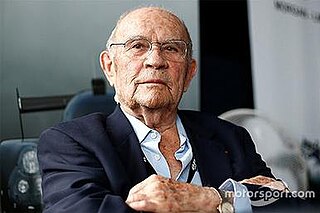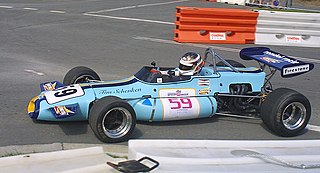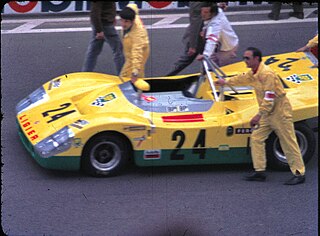Related Research Articles

Ligier is a French automobile and minibus maker created by former racing driver and rugby player Guy Ligier (1930–2015), specialized in the manufacturing of microcars. Ligier is best known for its involvement in the Formula 1 World Championship between 1976 and 1996.

Cosworth is a British automotive engineering company founded in London in 1958, specialising in high-performance internal combustion engines, powertrain, and electronics for automobile racing (motorsport) and mainstream automotive industries. Cosworth is based in Northampton, England, with facilities in Cottenham, England, Silverstone, England, and Indianapolis, IN, US.

Guy Camille Ligier was a French racing driver and team owner. He maintained many varied and successful careers over the course of his life, including rugby player, butcher, racing driver and Formula One team owner.

Gitanes is a French brand of cigarettes, owned and manufactured by Imperial Tobacco following their acquisition of Altadis in January 2008, having been owned by SEITA before that.

The Mirage Lightweight Racing Car was a family of race cars built by J.W. Automotive Engineereing (JWAE) at Slough in England, initially to compete in international sports car races in the colours of the Gulf Oil Corporation.

The Lotus 23 was designed by Colin Chapman as a small-displacement sports racing car. Nominally a two-seater, it was purpose-built for FIA Group 4 racing in 1962–1963. Unlike its predecessors Lotus 15 and 17, the engine was mounted amidship behind the driver in the similar configuration developed on Lotus 19.

The AC 3000ME is a mid-engined sports car originally sold by AC Cars. The two-door coupé debuted at the 1973 London Motor Show. Sales did not begin until 1979 and lasted until 1984. Rights to the 3000ME and tooling were transferred to a second company who managed to produce a small number of additional cars before going into receivership themselves in mid-1985. A third company acquired the rights to the car with plans to begin selling a revised version under a different name, but only a single prototype was ever produced.

Équipe Ligier is a motorsport team, best known for its Formula One team that operated from 1976 to 1996. The team was founded in 1968 by former French rugby union player Guy Ligier as a sports car manufacturer.
The Ligier JS7 was the second Formula One racing car made by Ligier. As with the preceding JS5, the letters "JS" were in tribute to Guy Ligier's friend Jo Schlesser who was killed in the 1968 French Grand Prix.

The Lotus 69 was an open-wheel formula racing car developed by Lotus in 1969 for use in Formula 2, Formula 3, and Formula Ford.

The Brabham BT23 was a formula racing car built by Brabham in 1967.

The Brabham BT36 was an open-wheel Formula 2 race car, designed by Ron Tauranac, and developed and built by British racing team and constructor, Brabham, for the 1971 European Formula Two Championship. Its best result that season was a 2nd-place finish in the championship for Argentine Carlos Reutemann, despite winning only one race, taking one pole position. His consistency and pace made this possible, scoring 6 podium finishes, and finishing the season with 40 points. The Brabham BT36 was constructed out of a complex tubular space frame, and was powered by the naturally-aspirated 1.6 L (98 cu in) Ford-FVA Cosworth four-cylinder engine, which produced 220 hp (160 kW), and drove the rear wheels through a 5-speed Hewland F.T.200 manual transmission.

The RAM 01, also known as the RAM March 01, is an open-wheel Formula One race car built by British team and constructor RAM Racing in 1983.

The Ligier JS2 is a mid-engined sports coupé that was built by Ligier in the French commune of Abrest near Vichy in the department of Allier between 1971 and 1975. Road-going and competition versions were built.

The Ligier JS3 is a sports-racing car built by Automobiles Ligier. It was unveiled in 1971 and ended its competition life the same year. Only one JS3, chassis JS3-01, was ever built.
Pichon-Parat was a French carrosserie based in the commune of Sens, in the department of Yonne. Established in 1952, it was known for producing custom cabriolet, coupé, estate car, and shooting brake conversions of established models from major automakers, and for building their own distinctive sporting models with completely original bodywork.

The Rondeau M379 is a Group 6 sports prototype race car, designed, developed and built by Automobiles Jean Rondeau, and competed in sports car racing between 1979 and 1988. It also notably successfully won the 24 Hours of Le Mans in 1980. During the 1981 24 Hours of Le Mans, two cars finished on the podium, but the race was marred by the death of Jean-Louis Lafosse, driving one of the five M379s entered in the event. It achieved one further win, at Monza in 1988. It scored a total of five podium finishes, and three class wins. It was powered by a 3.0 L (180 cu in), 460 hp (340 kW), Ford-Cosworth DFV V8 Formula One engine.The chassis is an aluminum-reinforced steel spaceframe, covered in a fiberglass panel body. This drove the rear wheels through a Hewland 5-speed manual transmission. This meant it was very light, with the total weight coming to 760 kg (1,680 lb).

The Chevron B16 was a Group 4 sports prototype race car, designed, developed, and built in 1969 by the British racing car manufacturer Chevron Cars as a two-seater racing sports car for the makes world championship. Brian Redman won the very first outing, the 500 km (310 mi) race at the Nürburgring on September 7, 1969, at a time of 3:13:01.6 hours. The last victory with a Chevron B16 was achieved by Clemens Schickentanz on July 11, 1971, in the sports car race at the Norisring.

The Lola T280, and its evolutions, the Lola T282, Lola T284, and Lola T286, are a series of 3-liter Group 5 sports prototype race cars, designed by Eric Broadley, John Barnard, and Patrick Head, and developed and built by British manufacturer and constructor Lola, for World Sportscar Championship sports car racing, between 1972 and 1976.
Michel Têtu, born 6 August 1941, is a French engineer best known as a designer of racing sports cars and Formula 1 (F1) cars for marques such as Ligier, Alfa Romeo, and Renault.
References
- 1 2 "Ligier JS1, 1970". auta5p.eu. Retrieved 2016-12-11.
- 1 2 3 4 5 6 7 Teissèdre, Jean-Marc (2014). Ligier, Prototypes & GT 1969-1975 et 2014[Ligier, Prototypes & GT 1969-1975 and 2014] (in French) (1st ed.).
- 1 2 3 4 5 6 "Ligier JS1". www.racingsportscars.com. Retrieved 2016-12-08.
- 1 2 "Guy Ligier's Biography". old.classic-days.fr. Archived from the original on 2017-08-25. Retrieved 2016-12-01.
- ↑ "Guy Ligier : le costaud de Vichyo". www.caradisiac.com. Retrieved 2016-12-09.
- ↑ "Ligier JS1 Ford". www.ultimatecarpages.com. Retrieved 2016-12-10.
- 1 2 3 4 "Modèles à la Une : la Ligier JS1". newsdanciennes.com. 24 July 2015. Retrieved 2016-12-09.
- 1 2 "Ligier JS1". ligiercars.com. Archived from the original on 2016-03-22.
- ↑ "Ligier JS2: l'hommage à Jo". boitierrouge.com. Retrieved 2016-12-01.
- ↑ "La Ligier JS1 exposée à Rétromobile". www.motorlegend.com. Retrieved 2016-12-10.
- ↑ "Ligier JS1 Ford Chassis: JS1-002". www.ultimatecarpage.com. Retrieved 2016-12-10.